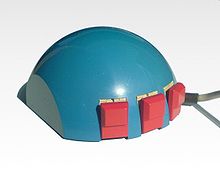
The trackball was invented by Tom Cranston, Fred Longstaff and Kenyon Taylor working on the Royal Canadian Navy's DATAR project in 1952. It used a standard Canadian five-pin bowling ball. It was not patented, as it was a secret military project.
Independently, Douglas Engelbart at the Stanford Research Institute invented the first mouse prototype in 1963, with the assistance of his colleague Bill English. They christened the device the mouse as early models had a cord attached to the rear part of the device looking like a tail and generally resembling the common mouse. Engelbart never received any royalties for it, as his patent ran out before it became widely used in personal computers.
The invention of the mouse was just a small part of Engelbart's much larger project, aimed at augmenting human intellect.

Several other experimental pointing-devices developed for Engelbart's oN-Line System (NLS) exploited different body movements – for example, head-mounted devices attached to the chin or nose – but ultimately the mouse won out because of its simplicity and convenience. The first mouse, a bulky device (pictured) used two gear-wheels perpendicular to each other: the rotation of each wheel translated into motion along one axis. Engelbart received patent US3,541,541 on November 17, 1970 for an "X-Y Position Indicator for a Display System".[7] At the time, Engelbart envisaged that users would hold the mouse continuously in one hand and type on a five-key chord keyset with the other. The concept was preceded in the 19th century by the telautograph, which also anticipated the fax machine.

Just a few weeks before Engelbart released his demo in 1968, a mouse has already been developed and published by the German company Telefunken. Unlike Engelbart's mouse, the Telefunken model had a ball, as it can be seen in most later models until today. Since 1970 it was shipped as a part and sold together with Telefunken Computers. Some models from the year 1972 are still well preserved.
The second marketed integrated mouse shipped as a part of a computer and intended for personal computer navigation came with the Xerox 8010 Star Information System in 1981. However, the mouse remained relatively obscure until the appearance of the Apple Macintosh, which included an updated version of the original Lisa Mouse. In 1984 PC columnist John C. Dvorak dismissively commented on the newly-released computer with a mouse: "There is no evidence that people want to use these things".